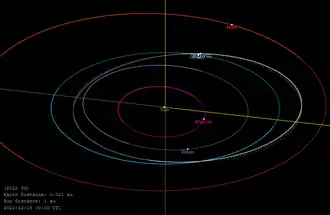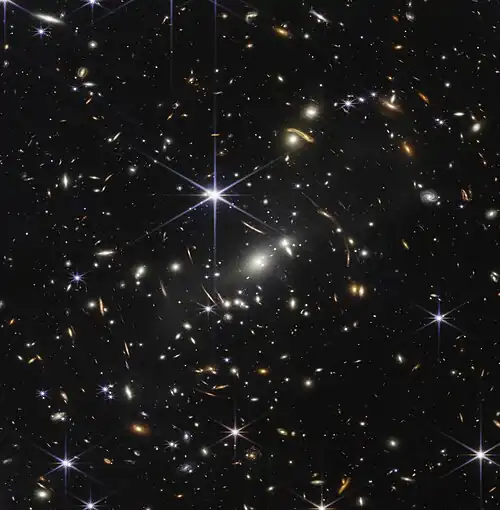2022 YG
 Orbit of 2022 YG | |
| Discovery[1] | |
|---|---|
| Discovered by | G. Borisov |
| Discovery site | MARGO Obs. |
| Discovery date | 15 December 2022 |
| Designations | |
| 2022 YG | |
| NEO · Apollo | |
| Orbital characteristics[2] | |
| Epoch 17 October 2024 (JD 2460600.5) | |
| Uncertainty parameter 2 | |
| Observation arc | 364 days |
| Aphelion | 1.200 AU |
| Perihelion | 0.806 AU |
| 1.003 AU | |
| Eccentricity | 0.1961 |
| 1.00 yr (366.90 days) | |
| 219.667° | |
| 0° 58m 52.3s / day | |
| Inclination | 2.364° |
| 273.973° | |
| 271.173° | |
| Earth MOID | 0.003133 AU (468,700 km; 1.219 LD) |
| Physical characteristics | |
| 26.70[2] | |
2022 YG is a near-Earth asteroid and a potential quasi-satellite of Earth, discovered by amateur astronomer Gennadiy Borisov at Nauchnyi, Crimea on 15 December 2022. It has an estimated diameter of 16–30 meters, given H of 26.7, and an albedo 4-15%.[a] Its closest approach to Earth was on 22 December 2022, at a distance of 0.0163 AU.[2]
Notes
References
- ^ "MPEC 2022-Y25 : 2022 YG". Minor Planet Electronic Circular. Minor Planet Center. 17 December 2022. Retrieved 20 December 2022.
- ^ a b c "JPL Small-Body Database Browser: (2022 YG)" (2023-12-14 last obs.). Jet Propulsion Laboratory. Retrieved 20 December 2022.
External links
- New Quasi-satellite 2022 YG – Animation of 2022 YG's orbit in a rotating reference frame with respect to Earth from 1900–2207, YouTube, 17 December 2022
- 2022 YG at the JPL Small-Body Database
- 2022 YG at ESA–space situational awareness
- 2022 YG at NeoDyS-2, Near Earth Objects—Dynamic Site

